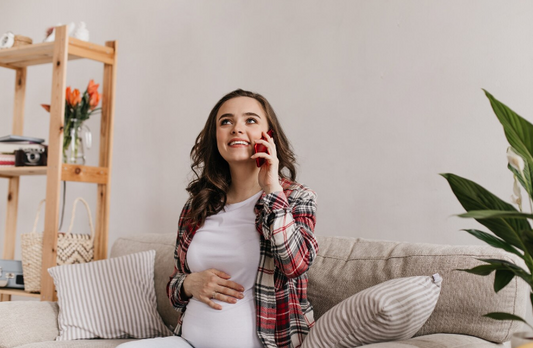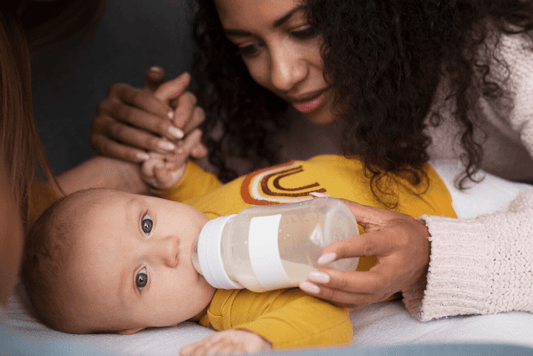Got your keys and wallet? Great! But saying goodbye to your little one can be tough when they make it a tearful event every time. So, what's a parent to do?
It's totally normal for one-year-olds to experience separation anxiety as they grow, but it can be really hard for us parents. Sometimes we might try sneaking out, downplaying our child's feelings, or even forcing the separation, but there's a better way to handle it that can help build trust.
In this article, we'll chat about what separation anxiety is, how it affects your child, what to avoid doing, and some tips on how to support your little one through it.
What is Separation Anxiety?
Separation anxiety is a natural part of your child's growth and typically happens between six and twenty-four months old. It shows that your little one is becoming more aware of their surroundings and the idea that they are separate from you.
While it can be a bit overwhelming, this stage is actually a positive sign that your child is progressing as they should. It's common for kids to feel anxious or upset when they can't see you because of this newfound realization.
They might cry, cling to you, or resist being comforted by others. They might also sweat, tremble, or have a faster heartbeat. But don't worry, these reactions are all totally normal.
How Does Separation Anxiety Affect Your Child?

Separation anxiety can have a big impact on your child's emotions and growth if not handled properly. For instance, if parents leave abruptly when their one-year-old is upset about them going, it can cause lasting anxiety and attachment issues.
Kids dealing with separation anxiety that hasn't been addressed might struggle with making friends and forming relationships later on. They could also have trouble sleeping or show signs of feeling down.
While separation anxiety is a normal part of childhood, it's important to help your child through it. Show them that you'll always come back, but building that trust takes time. It's all about taking things one step at a time!
How can I support my one-year-old as they deal with separation anxiety?
You might have noticed that just talking, reasoning, or making promises to your one-year-old doesn't help when he's feeling anxious. He just wants you, and if you're leaving, it's tough to soothe him with words alone.
But don't worry! There are some simple steps you can take to reassure your little one that you'll always return, even if you have to be away for a while. It all starts with these baby steps.
1. Routine
Establishing a regular routine before you head off to work can really help your child feel more comfortable and less anxious. Think of it like your other daily routines, like getting ready for bed or having meals together. It could be something simple like a fun little game with mom before you leave or a special hug from dad. You could even come up with silly handshakes, funny voices, or goofy dances to make it special.
Consider setting a timer and giving your little one a call from work to check in. It might be tough at first, but it can create something for them to look forward to after you've left in the morning (especially if they get to hold the phone!).
As you all get used to these routines, they'll start to flow together in a way that makes sense to your child. Of course, things might not always go as planned, and you might need to turn down some things to protect your family time, but it's worth it to ease this season of social anxiety.
2. Taking a Break
Try practicing short periods of separation with your one-year-old to show them that you will always return. Simply step out of the room for a few minutes and do something nearby, like washing dishes or cooking, while your child plays with their toys.
Initially, your little one might follow you around, but eventually, they will be content to play on their own while you're nearby. As they become more comfortable with you being out of sight, gradually increase the time you're away and vary how much they can hear you.
Next, try stepping outside for a few minutes. Maybe sit on the porch or do a task visible from a window. With time, your child will adjust to you being outside the front door.
When another caregiver is present, practice leaving for a few minutes. Slowly increase the time you're gone until you can run errands or have a night out without any issues. These small steps help build trust and reduce separation anxiety.
3. Say Goodbye
Saying goodbye is another important part of helping your little one get used to being apart from you. Even though it can be tough at first, saying goodbye and letting your child know you'll be back soon is important for helping them feel more comfortable with temporary separations. By practicing saying goodbye along with gradually increasing the time you're away, your child will start to feel more confident knowing you'll always return.
4. Comfort Objects
Offering comfort objects, such as stuffed animals or special blankets, can provide reassurance for young children who may feel anxious when their parents are not around. One-year-olds can find great comfort in holding onto these items, which can offer a sense of security that they can control.
It's fascinating how children at this age tend to develop a strong attachment to their comfort objects - they seem to believe there is something unique or even living about them, making them irreplaceable. Encouraging your child to take care of their comfort object while you're away can help them feel more secure and comforted in your absence.
5. Get Others Involved
It's important to have other caregivers help out with watching your little one from time to time. This is not only good for helping your child deal with separation anxiety but also for your own well-being. It's perfectly fine to take a break when needed.
You can have a trusted caregiver look after your child at your place or have your child spend time at their house. Personally, I found that leaving my toddlers with grandparents was the best for separation anxiety. Being in a different environment with "grandma's rules" seemed to work wonders.
Sure, kids might get a bit spoiled at someone else's house, but a little spoiling can actually be quite beneficial in helping a toddler through separation anxiety!
6. Patience
Separation anxiety is a normal part of your child's growth, so it's important to be patient while helping them through it. Remember to show lots of love and support during this time as it may take a while for them to adjust.
How you navigate your toddler's separation anxiety now can impact how they deal with anxiety in the future. Avoid sending mixed signals, getting upset, or mishandling the situation, as this could worsen their anxiety and lead to further challenges down the road.
So, what are some things to steer clear of when your little one is going through separation anxiety?
What are some things I should avoid doing when my one-year-old is experiencing separation anxiety?
When your one-year-old is upset because you're heading out, it can pull at your heartstrings. It's important to stay attuned to your little one's feelings and steer clear of actions that might make them feel more anxious.

Here are a few things to avoid doing when your one-year-old is feeling upset about your departure:
1. Leaving Without a Goodbye
Instead of sneaking out when your child isn't looking, it's best to say goodbye and work through a routine. Sneaking out can actually make separation anxiety worse because your child needs to trust that you'll come back. So, make sure to leave in a way that helps build trust and security.
2. Show Anxiety
Feeling worried or anxious when leaving your upset child is totally normal. But try not to show this to your little one, as they can pick up on it and become more anxious themselves. Stay calm, show love, and provide reassurance through hugs, kisses, and a simple goodbye routine. And if you're feeling anxious because you don't trust who you're leaving your child with, it's okay to trust your gut and find a different solution. Your child's safety is top priority!
3. Not considering your child's Feelings
Ignoring your child's emotions can leave them feeling unheard and anxious. Even though your one-year-old may not be able to communicate their feelings yet, they can still show signs of distress. It's tough for them when the person they love the most doesn't seem to understand.
Instead, try to listen to your child by acknowledging their feelings and showing that you understand: "I see that you're upset that I have to go, Clara."
Offer some comfort and reassurance: "I have to go out for a bit, but I'll be back before you know it. It's okay to feel sad when I leave, but you'll have a great time here, and we can read together when I get back."
Even though your toddler might not fully grasp everything you say right now, if you consistently label emotions like sadness, anxiety, and anger in the years to come, they will start using these words themselves.
4. Punish Your Child
Separation anxiety is a normal part of your toddler's emotional development and not something they can control. It's important not to punish your child for feeling anxious or displaying anxious behaviors.
Punishing your little one could actually make their anxiety worse and harm your relationship with them. Instead, offer love, support, a comforting item, or a quick goodbye ritual to help ease your toddler's anxiety. Consistently providing these reassurances will help your child feel more secure over time.
5. Force the Separation
Navigating big emotions with toddlers requires a delicate balance. While it's essential to show understanding and support, it's also important not to let your child use their anxiety to manipulate you. You have responsibilities, and your child needs to learn how to manage their feelings.
Even though it may be tempting to force a separation, it usually backfires. Pushing your child to separate can heighten their anxiety and damage trust between you. Instead, allow for some extra time before leaving to say goodbye, offer hugs, kisses, reassurance, and calming moments. Creating a little breathing space in your schedule can prevent acting out of frustration and make the whole process of leaving more relaxed.
How can I best support young foster kids or adopted toddlers with separation anxiety?

Dealing with separation anxiety in young foster or adopted kids can be a bit trickier due to their past experiences. Changes in their environment, caregivers, and routine can make them feel anxious and behave differently.
Even one-year-old foster children may show signs of fear of being abandoned and cling to those they trust. It's important to show them extra care and understanding during these moments of anxiety.
Taking small steps and following advice on how to handle separation anxiety gradually can make a big difference for these kids. If there are underlying traumas or special needs that you're not aware of, it's essential to reach out to the child's social worker or counselor for more specific guidance.
Remember, the little things you do, like saying goodbye in a sensitive way, can mean a lot to a foster or adopted child. Stay patient, and don't forget to seek help if you need it along the way!
To put it simply,
Separation anxiety is just a natural part of your child growing up, no need to worry! Instead of taking the easy way out with quick goodbyes, try showing your little one some extra love and care when you have to leave. By doing this, you're helping your child trust that you'll always come back.
Keep in mind, teaching your child to deal with their anxiety doesn't happen overnight. It might take some time and understanding on your part, but with lots of love and encouragement, your child will definitely learn to handle their feelings and grow even stronger.




